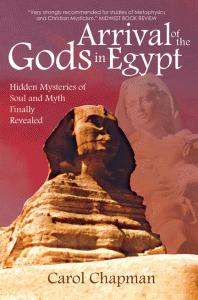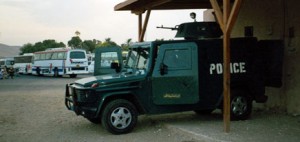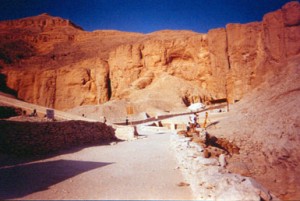The Pharaoh’s Headdress and Ancient Egyptian Gods
The Pharaoh’s Headdress and ancient Egyptian Gods. Why did the pharaohs use such a strange-looking headdress? A cloth with alternating dark and light stripes, plus a serpent on the forehead. Could it have been because of the mystical origins of the ancient Egyptian Gods?
Continue readingProof of the Afterlife in Egyptian Ruins?
Proof of the Afterlife in Egyptian ruins? Paintings in the pharaoh’s tomb illustrate proof of the afterlife based on past life memories of having been an eternal Light Being or Soul in Atlantis.
Continue readingSecret Room in King Tut’s Tomb?
I’m always excited at the thought of Egyptologists finding secrets chambers in ancient Egyptian 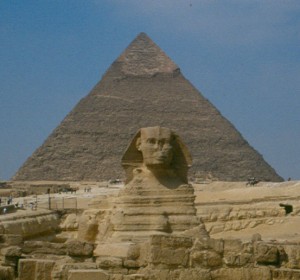 monuments. Of course, for me, the biggest prize would be a secret room in or beside either the Great Pyramid or the Great Sphinx.
monuments. Of course, for me, the biggest prize would be a secret room in or beside either the Great Pyramid or the Great Sphinx.
Therefore, when I read that Egypt Antiquities Minister Mamdouh el-Damaty agrees with British Egyptologist Nicholas Reeve’s contention that a queen could be buried behind the wall in a secret room in King Tut’s tomb, I take note. My thought is that, if there’s possibly a secret room in King Tut’s tomb, according to the NBC news article Egypt Says King Tut’s Tomb May Have Hidden Chambers, there may also be hidden chambers in other ancient Egyptian monuments.
I’m especially excited because of my past life memories of people from Atlantis traveling to ancient Egypt. Due to these reincarnation memories being so vivid, I traveled to Egypt to see the ancient Egyptian antiquities I’d revisited in my previous incarnations. I wrote about my adventures discovering images in the pharaoh’s tombs that illustrated my past life memories in Arrival of the Gods in Egypt. Among many other unusual concepts I present in that book, I talk about a secret, undiscovered room under the 2nd Great Pyramid. This is not the famous Great Pyramid–but the pyramid that’s in the middle of the three great pyramids and is connected to the Sphinx by a causeway. It’s the pyramid in the photo behind the Sphinx in the photo above.
Reviews of Arrival of the Gods in Egypt
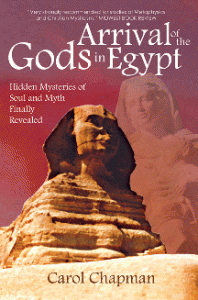 Here are some reviews of my second book, Arrival of the Gods in Egypt: Hidden Mysteries of Soul and Myth Finally Revealed.
Here are some reviews of my second book, Arrival of the Gods in Egypt: Hidden Mysteries of Soul and Myth Finally Revealed.
Jean C. Keating
Pulitzer-Prize nominated author of Beguiling Bundle
“A fascinating story that makes sense as the basis of our religions, Arrival of the Gods in Egypt delves deeply into the mystery of Atlantis and our souls’ beginnings on earth. Chapman expertly weaves the tale of a little known Marion apparition with an intriguing quest to discover evidence of Atlantis in the land of the pharaohs. By doing so, she reveals our true relationship with the Universe and offers hope for the future.”
Day Schwartz
Co-moderator, The Edgar Cayce Forum
“Unknown for thousands of years, amazing mystical evidence of Atlantis found in the pharaohs’ tombs plus the metaphysical mysteries of Mary’s appearances make this a page-turner of a book so exciting readers can’t put it down.”
Midwest Book Review
“Ancient Egypt is of endless appeal to those fascinated with history, with so many remnants of their culture and not even modern Egyptians truly understanding the significance. “Arrival of the Gods in Egypt: Hidden Mysteries of Soul and Myth Finally Revealed” is a wide reaching anthology of stories focusing on Egypt and the spiritual and occult connotations that many find in the culture. Discussing everything from the Egyptian creation myth to the origins of the Egyptian pantheon, “Arrival of the Gods in Egypt” is a must for anyone in need of an Egypt fix.”
(C) Midwest Book Revivew, 2008
Carol Haenni, PhD
Author of The Holy Women Around Jesus
“This fabulous story of the soul, mind and body, moving through a world where space and time are irrelevant, brings us face to face with the root races of humankind as they change from light beings to androgynous beings to mixed beings to human beings. Chapman takes us to Edgen, Egypt, Maya and places where apparitions of the Virgin Mary appear. Magnificent!”
Faye Roberts
Rapid City, South Dakota, US
“I recently read When We Were Gods and am finishing up The Arrival of the Gods in Egypt. To say they were positively fascinating would be an understatement, and the ring of pure truth in your somewhat unconventional ideas was simply unmistakable. My life will never be the same, and I now look at the world is a whole new way.. . . Thank you again for your time and for your wonderful, uplifting books that have given me so much to think about.”
Claire Gardner
Archives Specialist, Edgar Cayce Foundation
It was a joy to read and be taken on an adventure that felt excitingly familiar, believable, and comfortable. Through your writing, you brought me into a timeline of another dimension and I emerge smiling, knowing. You are truly blessed, and through your writings…bless others. Thank you.
Joan M. Kelchner
Reader, Carlisle, Pennsylvania, US
“In Arrival of the Gods in Egypt book Carol refers often to passages in When We Were Gods. Her references sparked my curiosity so much, that I sent for her earlier book. Between the two, I found enlightenment about Biblical references. Such as, “Disobedience was the original sin. Lack of humility, which kept us within God’s will, caused the Fall.” The Fall was us going from a vibrational state to a physical state and becoming trapped in the physical. Our longing to go Home (Heaven) is the desire to become a Light Being, a vibrational being again. Wow!
“When Jesus says, “I died for you,” he meant taking on the death of becoming human. He took physical form to show us “the way” out of the physical and back to the freedom of a Light Being. Amazing! I never understood that before! Such Love for humanity makes me feel humble.
“Your books clear up so much of my muddy thinking about Bible language and our origins. Also, reading about your experiences make me feel I’m on the threshold of something wonderful. A new way of thinking or perhaps understanding. I’m even beginning to understand the Edgar Cayce material more!
Thank you Carol.”
Diana Swenson
Co-author of Pawprints On My Heart
“Did winged serpents bring displaced Atlanteans to Egypt and the Yucatan to create their advanced cultures? In Arrival of the Gods in Egypt you will explore the possibility. The author has vivid memories of Atlantis and has followed them up with extensive research in this non-fiction history/mystery book.”
Find out more about Arrival of the Gods in Egypt.
Continue reading
Front and Back Cover of Arrival of the Gods in Egypt
Click on the below images to see them larger.
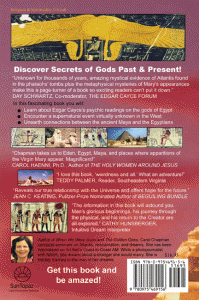 Find out more about Arrival of the Gods in Egypt.
Find out more about Arrival of the Gods in Egypt.
Continue reading
Book Excerpt from Arrival of the Gods in Egypt
 Arrival of the Gods in Egypt:
Arrival of the Gods in Egypt:
Hidden Mysteries of Soul and Myth Finally Revealed
Chapter Eight:
Russian Aircraft and Egyptian Tank Trucks
Air Flight to Luxor
I felt happy to find indications that the Great Pyramid and Great Sphinx may have been built during the time Atlantis was supposed to have existed. I had also seen for myself that a very advanced civilization may have built these ancient ruins. Hence, I believed it possible that the images painted on the walls of the pharaohs’ tombs in the Valley of the Kings might illustrate the ancient Egyptians’ legendary recollections of that time. I also hoped that these tomb images might illustrate my memories of Atlantis. Therefore, our next stop was the pharaohs’ tombs in the Valley of the Kings.
Many tourists who visit Egypt travel to the Valley of the Kings on a cruise ship that sails down the Nile to Luxor. We would not have the time to take a leisurely sightseeing cruise along the river.
We flew to Luxor instead. When I think back on it, I am again amazed that everything worked out so well for us. As Hani had promised, his cousin in Cairo owned a travel agency, and he had arranged our travel. As this was an in-country travel agency, we naturally flew Egypt Air.
I found our flight to be a new experience. Most of our fellow passengers were Egyptians. And, they were almost all men. Except for a couple of young women tourists who traveled with husbands or boyfriends, our fellow passengers had swarthy skin, jet black hair, and looked like they might be relatives of that dashingly handsome and famous movie actor of Dr. Zhivago fame, Omar Sharif. It was quite a difference from the blondes, brunettes, and blacks of the United States.
In addition, Peggy and I found it just a little bit disconcerting that all the signs in the plane such as “Exit” and “No Smoking,” were written in large graceful Arabic characters, and, in equally large and prominent letters, in Russian. Under the Arabic and Russian we found very tiny English lettering.
This could only mean one thing. The Egyptian aircraft on which we flew was not an American plane. It was Russian! Nonetheless, the flight was lovely—comfortable, enjoyable, and delightful—everything a person would want in commercial airline service.
Because we flew at night, the lights in the cabin were dimmed. Although Peggy and I should have felt apprehensive or even sleepy, because it was such a new situation for us, we felt like children who have been allowed to stay up later than our usual bedtime. We talked with energy and animation over the roar of the engine for the whole flight.
Luxor at Night
We arrived in Luxor in the middle of the night. The men with whom we had shared our flight deferred to us with consideration and politeness because we were women.
Our driver waited for us on the tarmac in the spotlight created by a light on a tall pole. This was not a big bustling airport. We walked off the plane, down a moveable ladder, and picked our luggage out from a pile on the tarmac.
All the other passengers scattered, leaving Peggy and me alone with the driver who loaded our luggage into his vehicle, which he had driven onto the tarmac. I felt grateful to have Peggy’s companionship, thankful she had offered to come with me.
It must have been quite late at night because we did not pass a single other vehicle on what seemed like a long drive from the airport to our hotel in Luxor.
The name, “Luxor,” is often used to signify the entire area of Egyptian ruins at the location that used to be the ancient city of Thebes, instead of just the town of Luxor. In cases where Luxor is used to describe the entire region, it is common to use the location descriptions of “West Bank” or “East Bank,” such as “The Temple of Luxor is located on the East Bank.”
Both the Temples of Luxor and Karnak are located on the East Bank of the Nile. However, most of the burial tombs of the pharaohs are located on the West Bank, many of them in the Valley of the Kings and the Valley of the Queens. The ancient Egyptians chose to bury their dead on the west side of the Nile because the sun set, or died, in the west.
Cruise Ships in the Nile
As we drove from the airport on the West Bank to our motel in the city of Luxor on the East Bank, we crossed a bridge over the Nile River. Everything—the bulrushes along the water, the moonlit road and the black water itself—felt quiet and still as if we drove through a museum display.
Anchored in the dark water below, I saw the lights of dozens of cruise ships. Probably hundreds, maybe even thousands, of tourists slept in these floating motels.
It all looked so crisp in the moonlight. The air smelled fresh but dry even when we crossed the bridge over the river. In the headlights of the car, everything looked brown, including the low scruffy bushes along the road.
As we drove along in this unfamiliar land, I realized that, for the first time, we were totally disconnected from the safety of our umbilical connection with Mohga. We had felt nurtured and safe with her. Now, we were on our own. What would we do if there was a problem with the hotel? Who would we call? Who would help us? Who would care?
Compared to Cairo, Luxor is a small town. Once inside the town, we drove along an empty street that paralleled the Nile. In the darkness, we could only see sleeping buildings on our left and a row of palm trees on our right, which I assumed lined the river. Everything in this desert area looked brown, even in the city.
As we approached the hotel, golden lights that beamed through the glass doors beckoned to us. When we checked into the hotel, the attendant gave us the choice of paying a slightly higher fee for a room with a view of the Nile. We opted to pay the higher fee.
It turned out that I wasted my money because I never inhabited the room in the daytime when I could have seen the Nile from my motel room. Instead, I spent all of my time exploring the nearby ruins.
From Luxor to the Valley of the Kings
As prearranged, the next morning our driver arrived before first light. Streetlights at the hotel entrance lit up his car parked by the curb. The sky had lightened to a dark gray by the time we drove out of town.
The driver seemed especially anxious to get to the entrance of the Valley of the Kings as quickly as possible. Not having been there before, I did not understand why he appeared to be in such a hurry. I could only think that he wanted to get us to the antiquities site while the air temperature was still comfortable.
The Valley of the Kings is an area rich in ancient Egyptian artifacts, located between the towns of Luxor and Karnak. Many pharaohs who lived from around 1540 to 1075 B. C. were buried in this area. Of these pharaohs, the best known to modern people is probably Tutankhamen or King Tut.
Nobles and their families were also buried in this area, as well as pets. The majority of the tombs have been ransacked by grave robbers, Tutankhamen’s to a much lesser extent than others. Because he was a minor king during his lifetime, experts believe that the treasures found in his tomb are merely a glimpse of the amazing artifacts originally contained in other pharaohs’ tombs.
Although several tombs are closed to the public, the extensive abundance of Egyptian monuments leaves a plethora of tourist-friendly places.
Nearby is another area of ancient Egyptian artifacts named the Valley of the Queens, since it was the area designated as the burial ground for important queens, such as Queen Hatshepsut.
Extra Security
The drive from the hotel to the entrance of the Valley of the Kings site appeared to be much shorter than the drive from the airport to the hotel. Once at the entranceway we quickly purchased our tickets. Only a few other people, all men, queued up with us at the ticket window. Perhaps they were all tour guides.
As I turned from the ticket window, I saw something I had not noticed in the darkness of the early morning shadows. Crouched under the overhanging rooftop of the building that housed the ticket sellers loomed an army truck with a gun turret on its roof. The gun pointed at the parking lot. A couple of military policemen, armed with machine guns, hovered at the ready nearby.
Until this moment, I had dismissed the number of military police in Egypt as equivalent to the number of policemen we have in the United States, believing that I had become so accustomed to police in our own society that they have become transparent to me.
However, the tank-at-the-ready produced a shock that made me realize that the situation in Egypt is much more dangerous than on U.S. streets. Of course the pyramids and the many other precious archeological sites in Egypt attract throngs of people from all over the world, so there is need for heightened security.
At the time, I did not know that 58 foreigners had been massacred by terrorists at the Valley of the Kings in 1997. No wonder John had been wary of visiting the land of the pharaohs. No wonder the Egyptian government needs to keep a tank-truck and machine-gun toting soldiers at the ready at the Valley of the Kings. I appreciated that they did.
The sun broke through the palm fronds at the horizon and at the same time, I heard the grumbling of a bus engine. I turned to observe the stinking behemoth swing into the dusty road alongside the parking area. The tourist bus took its place behind three cars parked in front of the closed entrance gate. Our driver scurried up to Peggy and me. He motioned anxiously to us, begging us to hasten into his car.
At first I could not understand why he was so anxious. As our driver frantically motioned toward his car, I saw the reason for his alarm. Rumbling on the road from the Nile River, a convoy of tourist buses bore down upon us, the fumes from their diesel engines causing dust to plume in clouds along the road.
I realized that they carried the hundreds of tourists who had spent the night on the dozens of cruise ships anchored in the Nile. I felt thankful that our driver knew to get us into the queue ahead of the buses. If we had had to wait for all the people on the buses to get off, our delay before we could enter the archeological site might have become interminable. By the time we got into the site the desert sun would have been frying us alive.
We ran to his car and made it to the entranceway before the buses. We were some of the first people to enter the premises.
Ahead of us, we saw walls of barren desert cliffs, which surrounded a valley. Along the floor of the valley, dry gravelly pathways wound from the entrance of one tomb to another.
As I walked through the gate, I saw a sign saying that the use of flash photography was prohibited inside the pharaohs’ tombs. I felt happy that I had consulted a guidebook before I left the United States and so knew to bring film and lenses suitable for low light photography.
The Tomb of Thothmose III
Through research, I had learned that many of the images I sought could be found in the tomb of Thothmose III. Therefore, aware that the desert sun rose steadily in the sky, Peggy and I passed the crowds moseying along from tomb to tomb. Instead, we used the map of the Valley of the Kings in our guidebook and headed straight to the entrance of King Thothmose III’s tomb.
As king of Egypt, Thothmose III brought great wealth to the country. He conquered Syria and most of the Euphrates Valley. He was the son of Thothmose II and a minor wife, Isis.
Although Thothmose III became king when his father died, he had to share the position with Thothmose II’s royal wife, Hatshepsut. During Hatshepsut’s approximately 22-year reign, Thothmose III had very little power. However, after her death, Thothmose III ruled Egypt for the duration of his life.
Peggy and I knew that once the crowds arrived, the atmosphere in the tomb would become increasing warmer, both from warm bodies and from the gain in heat from the relentless desert sun. In addition, I did not want to have to deal with people standing in front of the images I wanted to photograph.
I am happy that we rushed ahead because of a detail I had not anticipated. Thothmose III’s tomb has a false floor built about a foot high above the original stone floor. My guess is that this wooden platform is built to keep the many shuffling feet from stirring up dust in the enclosed space. Therefore, instead of walking on the actual floor of the tomb, visitors walk on this false floor made of wood. It looked somewhat like an indoor boardwalk.
Although the wooden floor created a pleasant walking surface, I had not anticipated the bounce created by the wooden planks. Once crowds started to pour into the tomb, I found it increasingly difficult to take photographs since the wooden platform bounced as the visitors tramped through the manmade cave.
Since the walls of the tomb were lit with only one row of fluorescent lights placed at the level of the false wooden floor, the paintings were not lit as well as I had hoped. Even with my fast film, I needed a very long exposure time.
With all the people bouncing on the wooden floor, I could not keep the camera steady enough for a long exposure no matter how tightly I jammed my elbows against my sides or how long I held my breath. Even when I held the camera like a rock, the floor beneath me caused the image to bounce. When I looked through the viewfinder to focus the image it appeared as if I stood on a trampoline.
That first hour or so in Thothmose III’s tomb, during the time when Peggy and I almost had the tomb to ourselves, was the best. I saw many images that corroborated my memories of Atlantis.
Find out more about Arrival of the Gods in Egypt.
Continue reading
Arrival of The Gods in Egypt Table of Contents
 Arrival of the Gods in Egypt:
Arrival of the Gods in Egypt:
Hidden Mysteries of Soul and Myth Finally Revealed
Table of Contents
Acknowledgements
Part I: Journey to the Land of the Pharaohs
1: Universe in Charge
2: Cairo at Night
3: Fat Karma and Death
4: Was It a Miraculous Healing?
Part II: The Gods Arrive in Egypt
Chapter 5: Panic in the Pyramid
Chapter 6: The Atlanteans and the Great Pyramid
Chapter 7: The Sphinx and the Woman with the Golden Hair
Chapter 8: Russian Aircraft and Egyptian Tank Trucks
Chapter 9: Who Was Eve?
Chapter 10: Scariest Memory of Atlantis
Chapter 11: Winged Serpents in the Pharaohs’ Tombs
Chapter 12: Light Beings in the Pharaoh’s Tomb
Chapter 13: Psychics, Mystics, and the Root Races
Chapter 14: Serpents, Root Races, and Myths
Part III: Encounter with a Goddess
Chapter 15: The Train Station and the Policeman
Chapter 16: Nighttime Pilgrimage
Chapter 17: Mary Appears in Asyut
Chapter 18: Did Mary Provide Protection?
Chapter 19: Blessed Among Women
Part IV: Gods of the Past and Present
Chapter 20: Twin Souls and Serpent Gods
Chapter 21: Amilius and Atlantis
Chapter 22: Mary for You
Bibliography
Online Resources
Index
Author Biography
Read more about Arrival of the Gods in Egypt.
Continue reading
Atlantean Hall of Records in the Edgar Cayce readings
Here’s a quote from America’s great psychic Edgar Cayce on the sealing of the Atlantean Hall of Records in the Great Pyramid:
Continue readingThe ceremony [sealing of the tomb of records at Gizeh] was long; the clanging of the apex by the gavel that was used in the sounding of the placing. Hence there has arisen from this ceremony many of those things that may be seen in the present; as the call to prayer, the church bell in the present, may be termed a descendant; the sounding of the trumpet as the call to arms, or that as revelry; the sound as of those that make for mourning, in the putting away of the body; the sounding as of ringing in the new year, the sounding as of the coming of the bridegroom; all have their inception from the sound that was made that kept the earth’s record of the earth’s building, as to that from the change.
Edgar Cayce Reading 378-14
Bosnian “Pyramids” are NOT really pyramids!
Remember the the Bosnian Pyramid of the Sun I was so enthusiastic about? It was supposed to be the tallest pyramid on earth, even taller than Egypt’s Great Pyramid. Well, it turns out they are not man made pyramids at all. Instead they are natural formations. According to an online Widipedia article entitled Bosnian Pyramids:
-
Amar Karapus, a curator at the National Museum of Bosnia and Herzegovina in Sarajevo, said “When I first read about the pyramids I thought it was a very funny joke. I just couldn’t believe that anyone in the world could believe this.”
Guess who believed it? Me! Don’t I feel silly now.
Continue readingDavidovits video shows composition of pyramid stones
If you’re interested in the how’s of building the Egyptian pyramids, take a look at the online video of Joseph Davidovits explaining, with a PowerPoint presentation, why geologists cannot see that the stones making up the Great Pyramid are made of re-agglomerated stone. Check it out. Scroll down to the bottom of the page for the video.
Continue reading